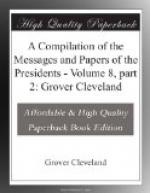sources of such rivers as the Connecticut and the
St. John must lie in a country sufficiently elevated
to be entitled to the epithet of highlands, although
it should appear on reaching it that it had the appearance
of a plain. Nay, it was even concluded, although,
as now appears, incorrectly—and it was not
feared that the conclusion would weaken the American
argument—that the line from the northwest
angle of Nova Scotia, at least as far as the sources
of Tuladi, did pass through a country of that description.
Opposite ground was taken in the argument of Great
Britain by her agent, but however acute and ingenious
were the processes of reasoning by which this argument
was supported, it remained in his hands without application,
for the line claimed by him on the part of his Government
was one having the same physical basis for its delineation
as that claimed by the agent of the United States,
namely, one joining the culminating points of the
valleys in which streams running in opposite directions
took their rise. The argument appears to have
been drawn while he hoped to be able to include Katahdin
and the other great mountains in that neighborhood
in his claimed boundary, and he does not appear to
have become aware how inapplicable it was in every
sense to the line by which he was, for want of a better,
compelled to abide. The British Government, however,
virtually abandoned the construction of their agent
in the convention signed in London the 27th September,
1827.[55]
[Footnote 55: See Note IX, p. 148.]
In this it was stipulated that Mitchell’s and
Map A should be admitted to the exclusion of all others
“as the only maps that shall be considered as
evidence” of the topography of the country, and
in the latter of these maps, constructed under the
joint direction of the British and American negotiators
by the astronomer of the British Government, it was
agreed that nothing but the water courses should be
represented. Finally, it was admitted in the report
of Messrs. Featherstonhaugh and Mudge that the terms
highlands and height of land are identical. The
decision of the King of the Netherlands, to which
Great Britain gave her assent in the first instance,
recognizes the correctness of the views entertained
in the American statements.[56] All discussion on
this subject is, however, rendered unnecessary by the
knowledge which the undersigned have obtained of the
country. The line surveyed by them not only divides
rivers, but possesses in a preeminent degree the character
by which in the British argument highlands are required
to be distinguished.
[Footnote 56: See Note X, pp. 148, 149.]




